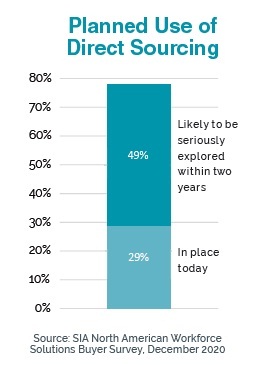Direct sourcing is not a new market trend. There have always been employers with the confidence and brand profile to go it alone and leverage their own internal candidate pools of former employees, retirees and applicants via their own applicant tracking systems.
The demand for direct sourcing has been quite cyclical in nature — someone in the organization recognizes that hiring is not a core competency and outsources it; after a few years, as part of a cost-cutting exercise, outsourced services are brought back in-house. Roll forward another couple of years and someone else decides that hiring is not a core competency and outsources it again, and so on.
More recently, however, the talent acquisition tools and services that can facilitate direct sourcing have evolved and multiplied to the extent that the demand for direct sourcing may become more structural in nature. This new wave of direct sourcing is supported by technology ranging from freelancer management systems to sourcing automation tools, candidate engagement technology, referral systems and a raft of verification and assessment tools.
This new technology has reinvigorated company candidate databases so that candidates are now much better engaged and better able to be mobilized. It also enables employers to pool candidates from a much wider range of potential sources so they can access talent across permanent, temporary and contract roles as part of a total talent approach.
According to SIA’s most recent North American Workforce Solutions Buyer Survey, 29% of large buyers of workforce solutions have a direct-sourcing solution in place already and another 49% are likely to explore it seriously within the next two years. While this aspiration may not turn out to truly reflect future market developments, it does threaten to squeeze out staffing firms and other intermediaries.
In reaction, a number of MSPs have sought to capitalize on this demand by offering talent curation services and technology solutions, enabling clients to benefit from better access to talent and lower prices without having to invest in new technology or internal teams. In order to access a broader talent ecosystem, MSPs have also been investing in partnerships and solutions to build their external and internal talent pool capability.
While they mostly target staffing firms to assist in their digital transformations, vendors offering Staffing Platforms-as-a-Service (SPaaS) — such as WorkN, Temp-Buddy and NextCrew — have started to create platforms on behalf of employers who want to fully leverage their employer brands to directly source contingent talent.
Staying Relevant
 If staffing firms find that demand does not come back as strongly as expected in 2021, growth in direct sourcing may be the culprit. Accordingly, it has never been more important for them to clarify and promote their value proposition to clients.
If staffing firms find that demand does not come back as strongly as expected in 2021, growth in direct sourcing may be the culprit. Accordingly, it has never been more important for them to clarify and promote their value proposition to clients.
All of the new technology available for staffing firms to source, validate and engage talent is also available for their clients to use. Therefore, staffing firms must master that technology if they want to remain relevant. If you allow your clients to become better at using new technology than you, then you won’t deserve to remain in business.
At the same time, staffing firms do not have to sit idly by and allow this disruption to unfold around them. There is also an opportunity to take a proactive approach and provide curation services to clients who want to direct source.
New-wave direct sourcing does not necessarily mean that 100% of a company’s hiring will be done in-house and with no relationships with intermediaries. Quite logically, hybrid solutions will be common, where the employer sources highly skilled, highly specialized roles directly but relies on staffing partners to source other types of talent, or even serve as a back-up when the client’s own candidate database isn’t able to provide a timely result. Staffing firms can step in here to help their clients structure an effective hiring program even if all vacancies don’t get sent to them in the first instance.
While direct sourcing has never been easier for employers, the proliferation of new technologies and the need to effectively integrate them to create a cohesive and frictionless direct-sourcing process make this a very complex exercise. Accordingly, some staffing firms have stepped in to help clients cut through the complexity, such as Canadian staffing firm Ian Martin Group with its managed direct-sourcing service.
The staffing industry has shown plenty of ability to adapt to new market trends in the past and there is no reason the growth in demand for new-wave direct sourcing needs to become a drag on progress.







